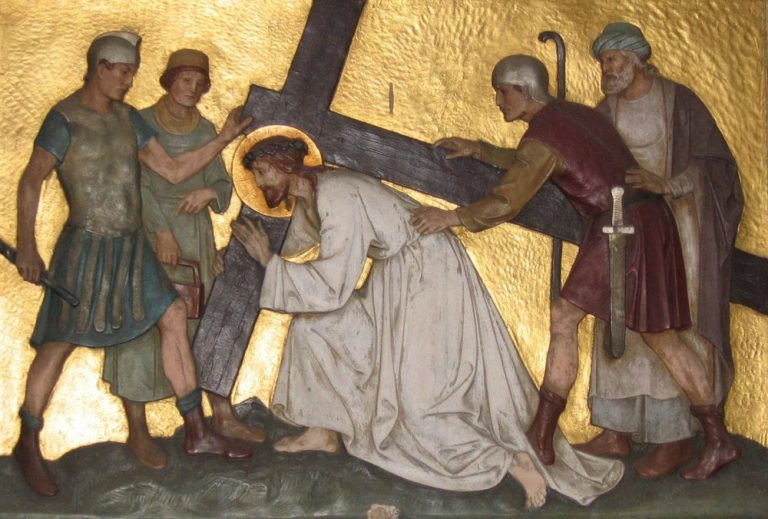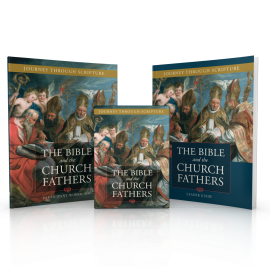By Mike Aquilina
Mike Aquilina is the award-winning author of more than fifty books on Catholic history, doctrine, and devotion. He is executive vice-president of the St. Paul Center for Biblical Theology and a contributing editor to Angelus News.

The way of the Cross is the inevitable way of a Christian’s heart. Indeed, it is almost impossible to imagine the Church without the devotion that goes by that name. It goes by other names, too: “The Stations of the Cross,” “Via Crucis,” “Via Dolorosa”—or just “the stations.” The practice has settled, for several centuries now, into brief meditations on fourteen scenes from the suffering and death of Jesus Christ. Why are Christians drawn so strongly to this devotion? Because Jesus wanted us to be. “Then he said to all, ‘If any man would come after me, let him deny himself and take up his cross daily and follow me’” (Luke 9:23). When Jesus speaks the words “if ” or “unless,” Christians listen carefully. For then Our Lord is laying down the conditions of our discipleship—the prerequisites of heaven.
The way of the Cross developed gradually in the life of the Church. In the Roman world, the Cross was a “stumbling block” (Galatians 5:11). Crucifixion was a most humiliating form of execution: a man was stripped naked and suspended in a public place; he was pelted with rocks and trash and left to suffocate slowly while passersby mocked his agony.
Crucifixion was still a common occurrence during the first three centuries of Christianity, so it was not easy for believers, like St. Paul, to “boast” (Gal 6:14) of the Cross. For people who had seen criminals crucified, the Cross could not have been an easy thing to love.
Yet love it they did. Devotion to the Cross pervades the earliest Christian writings. And the earliest records of pilgrimage show us that Christians endured great hardships—traveling thousands of miles, from France and Spain to Jerusalem—so that they could walk the streets of Jesus’ suffering: the Way of the Cross.
The Jerusalem liturgy of Holy Week memorialized the events of Jesus’ Passion. On Holy Thursday, the bishop led the procession from the Garden of Gethsemane to Calvary.
After Christianity was legalized in AD 313, pilgrims regularly thronged Jerusalem. The Way of the Cross became one of the standard routes for pilgrims and tourists. It wound its way through narrow streets, from the site of Pilate’s Praetorium to the summit of Calvary to the sepulcher where Jesus was laid to rest.
How did they know the sites of these events? One ancient story holds that the Virgin Mary continued to visit those places, every day for the rest of her life. Surely, the apostles and the first generation would hold dear the memories of Jesus’ Passion and pass them on.
Very likely, the route emerged from the oral history of Palestinian Christians and from the ambitious archeological excavations of the devout empress Helena. Along the way, pilgrims and guides paused at several places traditionally associated with biblical scenes—such as Jesus’ conversation with the women of Jerusalem (Luke 23:27–31)—as well as some scenes not recorded in the Bible. These occasional pauses were known in Latin as stationes. By the eighth century, they were a standard part of the Jerusalem pilgrimage.
Such pilgrimages grew in popularity well into the age of the crusaders. Gradually, the stations became more developed. In fact, history records many different series, varying in number, content and form.
In 1342, the Church entrusted the Franciscan order with the care of the holy sites, and it was these friars who most ardently promoted the praying of the Way of the Cross. Around this time, the popes began to grant indulgences to anyone who devoutly prayed the stations in Jerusalem. Also at this time, the Franciscans began to spread the Marian hymn that would eventually be most closely associated with the devotion: the Latin Stabat Mater, familiarly rendered in English beginning with the words:
At the cross, her station keeping, Stood the mournful mother weeping, Close to Jesus to the last.
The lyric is attributed to a Franciscan, Jacopone da Todi, who died in 1306.
European pilgrims were so impressed by the Jerusalem tour that they took the Way home with them. Around the fifteenth century they began to build symbolic replicas of the stations in the churches and monasteries of their homelands. Eight stations had been standard in Jerusalem, but these expanded to as many as thirty-seven in Europe.
The practice became enormously popular. Now everyone—small children, the poor, the infirm—could make their spiritual pilgrimage to Jerusalem, to the Way of the Cross. In a tangible way, they could take up their cross—just as Jesus had commanded—and follow Him to the end.
In the seventeenth and eighteenth centuries, the Stations of the Cross, now settled at fourteen, were considered almost standard equipment in a church building. Some were elaborate—dramatic, life-sized wood carvings of the human figures. Others were mere roman numerals—I through XIV— carved into the church wall at intervals. The popes extended the indulgences customary for Jerusalem pilgrims to Christians everywhere, if they prayed the stations in their own churches in the prescribed way.
The stations continued to be associated with the Franciscan order, and Church law often required that stations be installed (or at least blessed) by a Franciscan priest.
“If any man would come after me, let him deny himself and take up his cross daily and follow me.” Jesus said this to “all,” to every Christian. In the earliest days of the Church, it was perhaps easier to know the gravity of His command. The Cross was not yet a symbol. It was a horror that took place, with some frequency, at the edges of town. It was the worst death they could imagine, devised by people who possessed a certain genius for torture.
When Christianity became the official religion of the empire, crucifixion was outlawed. Over time, the most basic Christian devotion—devotion to the Cross of Jesus—began to require an act of imagination.
Today, our need is greater still. For we have sanitized even ordinary death: shutting it up in hospitals, silencing its agonies with drugs. The shame, the gore, and the stench—the commonplaces of public executions—have become incomprehensible. This is the cost of our everyday sins, and yet it is a sum, like the national debt, that is so remote from us that we cannot get worked up over it.
If we pray the Way of the Cross, we cannot help but get worked up. Through the stations we draw near, in our hearts and minds, our intellect and will and imagination, to the scenes beheld by our ancestors. We see a young man scourged with coarse leather whips studded with shards of pottery. His bleeding shoulders, with every nerve raw and exposed, receive a rough wooden beam, heavy enough to hold a man’s dead weight. He totters under the weight amid a jeering crowd. Delirious, He weaves along the cobblestones and stumbles, now crushed downward by the wood on His shoulders. His fall gives Him no rest, as the crowd mocks Him by kicking Him, stepping on His raw wounds, spitting in His face. He will fall again and again. When at last He reaches His destination, His torturers pierce the nerves in His hands with nails, affixing Him to the crossbeam, and then raise Him up, placing the beam atop another, thicker beam set perpendicular to the ground. His weakened torso slumps forward, compressing His diaphragm, making it impossible for Him to breathe. To take a breath, He must push up on the nail in His feet or pull up on the nails that pierce His arms. Every breath will cost Him an extremity of pain, until He succumbs to shock or suffocation or blood loss.
This is the hard part of Christianity: our faith cannot exist apart from devotion to the Cross. Our ancestors longed to touch the relics of the true Cross. Even our separated brethren love to survey the old rugged Cross.
It all seems unbearable. But Christ has borne it, and He insisted that we must, too. We cannot be lifted up to heaven except by way of the Cross. Tradition has mapped out the way for us.
You Might Also Like
The Bible and the Church Fathers is the fourth study in the Journey Through Scripture series. In twelve beautifully produced lessons, you will learn who the early Church Fathers were and how they shaped the way we read Scripture. You’ll discover the Church’s favorite tools for reading it, and you’ll understand Scripture’s relationship to Tradition and, in particular, to the Sacraments.
What’s more, you’ll recognize the powerful effect of Scripture on the Church Fathers. For them, this was no academic pursuit. Their love of God’s Word transformed their lives—just as it has the power to transform ours today.


